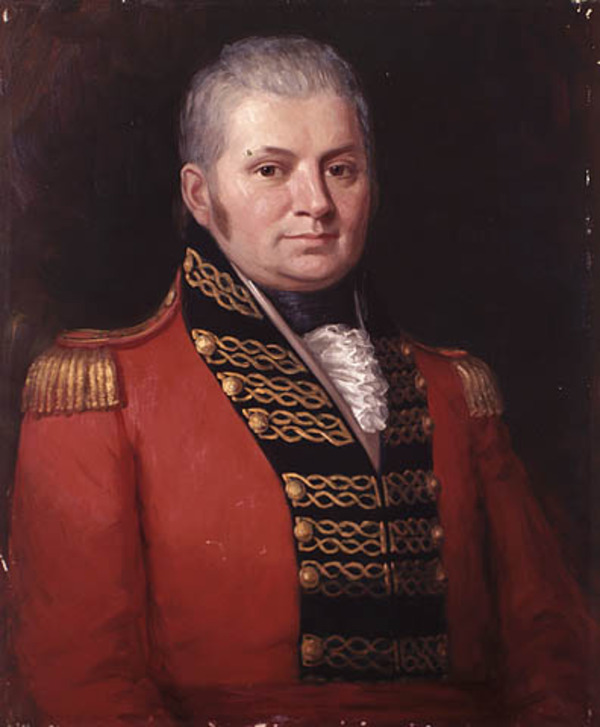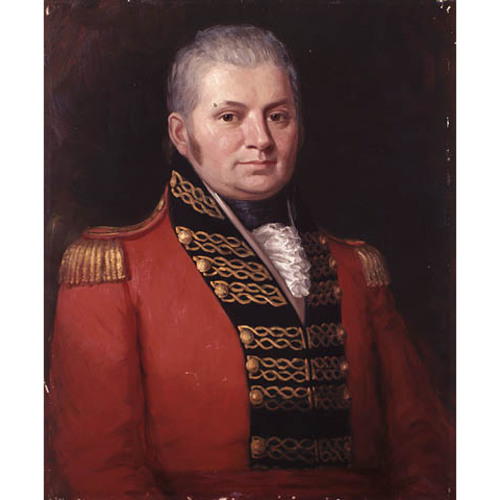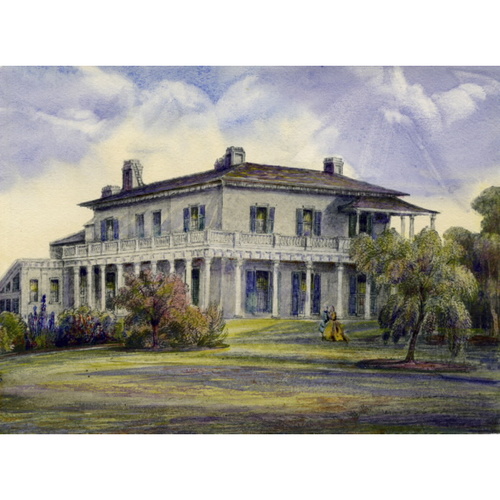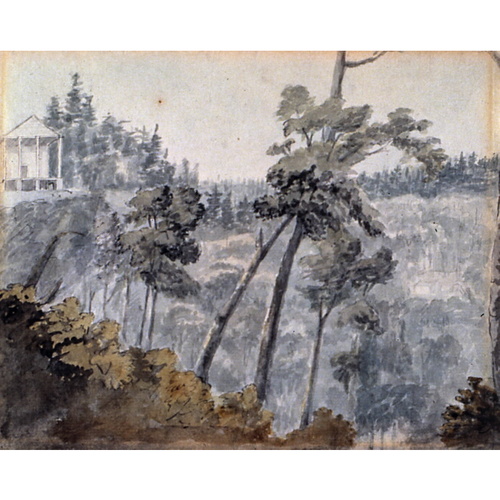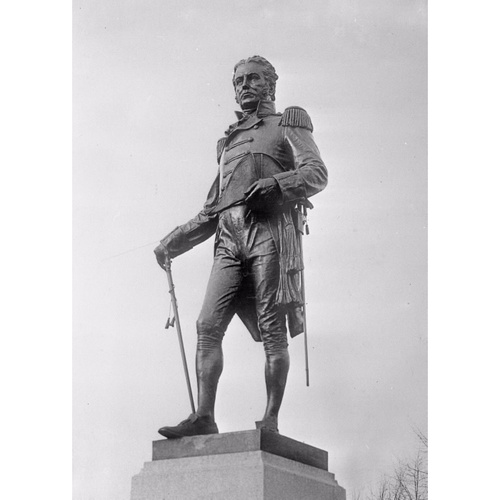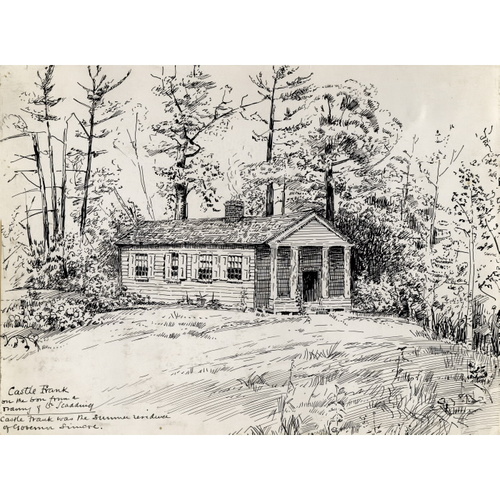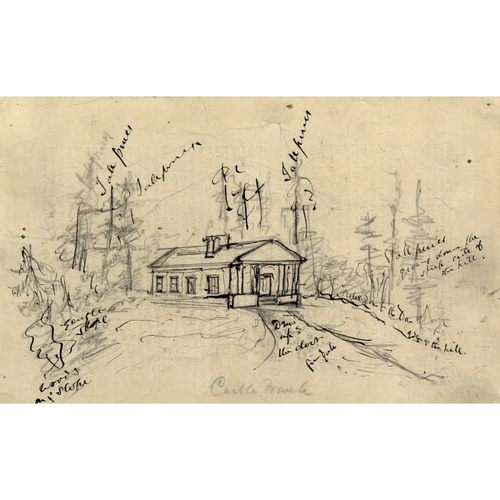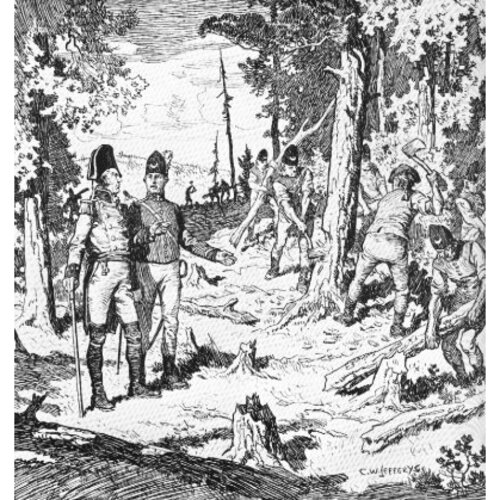SIMCOE, JOHN GRAVES, army officer and colonial administrator: b. 25 Feb. 1752 in Cotterstock, England, son of Captain John Simcoe, a naval officer, and Katherine Stamford; m. 30 Dec. 1782 Elizabeth Posthuma Gwillim*, and they had 11 children; d. 26 Oct. 1806 in Exeter, England.
John Graves Simcoe was the third of four sons, and the only one to live past childhood. His father died, most probably of pneumonia, on the Quebec expedition of 1759, and the family moved to his mother’s home, Exeter. Educated at Exeter Grammar School and Eton College, he did not show his father’s aptitude for mathematics, but he seems to have been a serious student of modern history (although it was not on the curriculum of either of his schools), and of English and Latin poetry. He continued to write verse occasionally for most of his life. After a year at Merton College, Oxford, he was admitted to Lincoln’s Inn, but then decided to follow the military career for which his father had intended him. That officer had drawn up a set of maxims for his sons’ education, to which Simcoe often referred. They emphasized industry, devotion to duty, conventional morality, the necessity of formal education in addition to military studies, and the appropriateness of an officer’s training for civil as well as military appointments. After a year under a military tutor at Exeter, Simcoe obtained a commission in 1770 as ensign in the 35th Foot, through the influence of his mother’s family.
The regiment was sent to Boston, Mass., in 1775, Simcoe arriving two days after the battle of Bunker Hill. During the siege of the town he purchased a captaincy in the 40th Foot, the regiment with which he was to serve in the Long Island campaign, the capture of New York City, and the New Jersey campaigns of 1776–77. He received the first and most serious of his three wounds at the battle of Brandywine, in Pennsylvania; the uncertain health from which he suffered for the rest of his life had, however, begun earlier. Convinced that the British army had no appreciation of light infantry and that no European army had properly organized light cavalry, he wanted to form a combined light corps which would be especially suited for service in America but would also introduce a more general reform of British military practice. After being refused permission to raise a corps from among the free blacks of Boston, he obtained command on 15 Oct. 1777 of the Queen’s Rangers with the provincial rank of major.
The Rangers, a loyalist corps raised a year earlier, had suffered heavy losses. Simcoe brought them up to strength, mainly by recruiting loyalist refugees and American deserters. Organized in 11 companies of about 30 men each – one hussars, one grenadiers, and the rest light infantry – they served continuously for the duration of the war as reconnaissance and outpost troops: in the Pennsylvania campaign of 1778 and the subsequent retreat to New York, in Benedict Arnold’s raid on Richmond, Va, and in the Yorktown campaign. Their training gave little attention to formal drill, but insisted on physical fitness, rapid movement, bayonet fighting, and, most particularly, discipline in the field. Simcoe made the exaggerated claim that the corps never gave a false alarm, never destroyed civilian property, never had a sentry surprised, and only once lost a patrol. He was himself captured in an ambush in 1779 and spent six months as a prisoner. He was invalided home just before the surrender of Yorktown in 1781. The war had been for him a great personal success: he had risen in army rank from lieutenant to lieutenant-colonel; in action he had been one of the two or three most consistently successful of British regimental commanders; and he had acquired a reputation as a tactical theorist, which was soon enhanced by the publication at Exeter in 1787 of his Journal of the operations of the Queen’s Rangers.
He convalesced at the Devon home of Admiral Samuel Graves, his godfather, whose ward he married. Elizabeth Posthuma Gwillim was a considerable heiress. She bought a 5,000-acre estate at Honiton in Devon, and built Wolford Lodge, which was to be the family seat until 1923. Simcoe’s own financial resources seem to have been trivial in comparison. Unwilling to retire into private life, he was elected to the House of Commons in the government interest for the Cornish borough of St Mawes in 1790. In a brief and obscure parliamentary career, his only reported speeches were on the new constitution for Quebec and on the resumed impeachment of Warren Hastings, although he perhaps also spoke on a motion to abolish the slave trade. His main interest in politics was to secure a military or a colonial appointment. His proposals to raise a corps on the lines of the disbanded Queen’s Rangers and (when there seemed danger of a war with Spain) to lead an expedition against Cadiz were unsuccessful, but by the summer of 1790 he was promised the lieutenant governorship of what was to be the new loyalist province of Upper Canada. His hopes that he would not be subordinate to Lord Dorchester [Guy Carleton] at Quebec, Lower Canada, were disappointed when their commissions, both issued on 12 Sept. 1791, gave the latter authority over both provinces as governor-in-chief.
The Upper Canadian appointment was not Simcoe’s first choice – he hoped to exchange it for the post of British minister to the United States – but he brought to it all of his characteristic zeal. By the time he entered Upper Canada on 24 June 1792 he had spent 18 months in preparing to inaugurate its government. Encouraged by his neighbour Sir George Yonge, secretary at War, who was a fellow enthusiast for overseas settlement, Simcoe had offered a series of ambitious and unrealistically expensive plans for the rapid economic, constitutional, religious, and educational development of his new province. Except for his first speech to the legislature at Newark (Niagara-on-the-Lake) on 17 Sept. 1792, his most celebrated utterances on making Upper Canada a model of England overseas date from that period, before he had seen the province.
The political faith that his appointment gave him occasion to express was thoroughly tory, but his toryism was by no means entirely insular. He had retained from the American war a special enthusiasm for North America and for continued British rule in it. His father had been struck by the prospect of mercantilist expansion, based on the St Lawrence and extending into the interior as far as the isthmus of Panama. For Simcoe, who romanticized his father’s role in the Seven Years’ War, the task of vindicating British imperialism by making it work in Upper Canada was both a filial and a patriotic duty. He had also a genuine sympathy towards loyalist exiles, with some of whom he had maintained a connection. In 1792 he still shared the belief, common among his brother officers, that the Americans were becoming disillusioned with independence, and that the western settlements would not join the union even if it lasted. But he also had a far from grudging admiration for American, especially New England, practicality. Although he once described his opinion of Americans as a mixture of “military contempt” and “civil dessecration,” he thought that they had no equals as agricultural settlers or as entrepreneurs of pioneer commerce. The revolution had been, in his view, the result of democratic excess, but he did not think that excessive democracy was the normally dominant characteristic of American society. If his constitutional models for Upper Canada were avowedly British, his models of economic progress were basically American. When he wrote of defeating “the spirit of democratic subversion, in the very Country which gave it existence and growth,” he was relying not merely on the transplanting of British institutions but on the underlying strength of conservatism in North America.
He therefore saw no contradiction in depending on American immigration to populate a British colony, although he did once suggest that it might be leavened by transferring the settlers of Newfoundland to Upper Canada. The picture of him as deceived by professions of “late loyalism,” first drawn in La Rochefoucauld-Liancourt*’s Travels, is false. “The Preference of the British form of Government is alledged by some for quitting the States,” he wrote after a year and a half in the province, “but the Oppression of the Land Jobbers, and the uncertainty of the Titles is the more general Reason.” He expected that new settlers would be “attached to the British Government or hostile to it by the result of their own comparison and investigation,” and that their main concern would be “the undisturbed possession of present benefits and the prospect of future advantages for their families.” The loyalty of immigrants would be commanded by a good land-granting system and by the efficient administration of what was basically a familiar constitution.
Clear about the objects of granting land, Simcoe never got a secure grip on its actual administration. He was quick to take an interest in the details of its planning, such as the distribution of crown and clergy reserves throughout townships or the elaborate zoning regulations for town lots in York (Toronto). He was slower to deal with gaps between plans and practice. He began with great faith in granting whole townships to individual applicants, who were to act as organizers of settlement and in turn to be accepted as a sort of local gentry. Twenty-six such grants were made in his first year. Ineffective though the system proved to be, he did not abandon it. The number and size of large grants in fact grew annually, in some part as he and other officials took advantage of their generous land allowances. More than two-thirds of his grants in the new Home District were of over 500 acres, and the best locations generally went to officers of government. He himself seems to have taken only the 5,000 acres due to his military rank, although he was careful to locate more than 1,000 acres in each of the areas – York Township and the Western District – where his government did most to encourage settlement. His family held the lands until 1832, and then sold them all over the next 21 years, mostly to or through William Allan*.
Impatient with the district land boards, set up in 1788 to ensure orderly and loyal settlement, Simcoe often ordered large grants himself. Some of his grants, meant to attract settlement and direct it to particular locations, were of lands to which the title was not clear. His grant to William Berczy is the notorious but by no means the only case. After he secured the abolition of the land boards in 1794, there was really no machinery left to screen applicants for land. It was fortunate that the most consistently able of his subordinate officials, David William Smith*, was deputy surveyor general. In the short run, the regulations designed to check speculation did not work; in the long run they contributed to confusion and delay in issuing legal titles. Yet the land system did meet Simcoe’s immediate object of making Upper Canada a place where settlers found land easy to get.
In practice, his policy amounted to little more than the acceptance of settlement as it came. The plan he had laid in England was more ambitious, to control not only the location but also the nature of new settlements. The instrument intended for that purpose was his provincial corps, the second Queen’s Rangers, and the model of their proposed operation was the Roman military colony. The winter quarters of Ranger detachments were to mark the sites of new towns, settlers being attracted by the clearing and road building that the troops would do, as well as by the markets and protection they would afford. Disbanded Rangers would form the nuclei of settlements; around them immigrants would “coalesce into the general principles of British Subjects.” This plan was the most cherished of Simcoe’s projects for Upper Canada. He saw it as the antidote to the insidious growth of frontier democracy and as exemplifying the “wise Principle . . . of blending civil & military Advantages.” It exemplified, too, his tendency to attach exalted expectations to measures perfectly sensible in themselves and to request financing on the scale of his expectations. The Rangers’ function as prophets of social cohesion never received a fair test of its impracticality, because neither the imperial government nor the commander-in-chief at Quebec could be induced to think of them as anything but ordinary troops. The twelve companies that Simcoe proposed, including a cavalry detachment and artificers, were reduced to two infantry companies. His claim to be able to assign them without the commander-in-chief’s approval was also denied: Lord Dorchester finally asserted his authority over their employment in June 1796. Until they were disbanded in 1802, the Rangers continued to be important to Upper Canada chiefly as road builders.
More generally, Simcoe was unable to persuade the imperial administration that his province should be treated like a special foundation, not a normal colony. His recommendation that the Indian Department be transferred from the commander-in-chief to the civil government of Upper Canada was later accepted; otherwise, his failure to escape from Dorchester’s military authority was complete. His attempt to maintain a separate commissariat in the upper province was disallowed, after his nominee, John McGill*, had served for two years without pay. His practice of requisitioning military supplies for civil works, and even for rations to settlers in the hard winter of 1795–96, was stopped. The Treasury relented in its slow pursuit of his improperly authorized expenditures only after his death. The proposals he endorsed for imperial assistance to capture for Upper Canada the trade of the American west were rejected or ignored. He had to discontinue appointing lieutenants of counties. He was not allowed to introduce municipal corporations, although he argued for them both as instruments of economic progress and as anti-democratic institutions. Neither the imperial government nor the provincial legislature shared his sense of urgency for the public support of education. His plan for a provincial university, with preparatory schools at Kingston and Newark, was vetoed in Whitehall as premature, besides costing £1,000 a year. The legislature, although it repeated his request for imperial assistance in the year after his departure, did not undertake to assist grammar schools until 1807. His strongest personal disappointment – strongest, at least, after the curbing of his plans for the Queen’s Rangers – came from the refusal of full endowment to the Church of England in Upper Canada. His arguments stressed the church’s importance in reinforcing social and political conservatism, but he was also deeply if conventionally devout. His hopes, raised a second time by the appointment of Jacob Mountain* as Anglican bishop for the diocese of Quebec in 1793, were dashed by the news that the church would have to wait for the day, which he knew could not be soon, when the clergy reserves were productive. What Simcoe called “due support” for his province could not be fitted into an annual establishment for Upper Canada of £20,000. After four years of almost unrelieved disappointments, his original sense of mission became very like a sense of grievance. He remained convinced that his plans had been eroded by ministerial indifference and warned that his successor must be treated more generously: “a Want of System and [of] a Continuity of Measures in colonial Governments is an evil of serious magnitude.”
It was no accident that Simcoe’s quarrels were nearly all with his distant superiors. Within the province, his most fundamental task was to provide a framework of civil government, the details of which were not often of special interest to pioneer settlers. He was disappointed in the social status and education of the members of the legislative assembly when he first met them, but in five sessions their objects seldom conflicted with his. Most of the legislation put before them, especially in their first session, was altogether uncontroversial: the adoption of English civil law and of jury trials, of standard English weights and measures and of tavern licensing, and the provision of jails and courthouses in each of the four administrative districts. During his whole term of office, the assembly rejected only two measures that he was anxious for – a land tax and an education bill. In May 1793 it obliged him to settle for the gradual rather than the immediate abolition of slavery in the province. In the next year it accepted a court of king’s bench with obvious reluctance. The assembly also faced him with two unwelcome initiatives of its own. He had to concede the legalization of marriages performed by magistrates. He insisted on a qualification: if there were five Anglican clergymen in the district, one of them within eighteen miles, the bill did not apply. He effectively defeated attempts to introduce elective town meetings on the New England model. A bill of 1793 put the election of township officers under the control of justices of the peace, who were appointed by the lieutenant governor and remained the real power of local government. On the whole, he had reason for his annual expressions of satisfaction with the assembly.
He had rather more difficulty with the Legislative Council. His general distrust of merchants and speculators applied with uncomfortable directness to some of its members. There were fewer than ten councillors, never all assembled; and in so small a body his pompously defensive reaction to criticism was a disadvantage. There, also, the developing rivalry of sectional interests found clearer expression. His original idea of the council gave some weight to the independent judgement of its members, but in practice he expected it to act as an adjunct to his administration. Still, he managed after three sessions to find common ground with both of his occasionally outspoken critics on the council: with Robert Hamilton of the Niagara area on the encouragement of western commerce and with Richard Cartwright of Kingston on the need for municipal councils.
In the microcosm of Upper Canadian politics, Simcoe’s accessibility, candour, and evident desire to please were very serviceable qualities. They made up for his inexperience in civil administration and for his failure to acquire the skills of political manœuvre and compromise. Watchful though he was of his status and perquisites, he was a warm and sympathetic man, with an intense loyalty to his subordinates. Even Chief Justice William Osgoode*, who had a lawyer’s contempt for military intellects, conceded him affection. It cannot be said that the provincial administration met his expressed ideal that there should “neither be a sine cure mind nor a sine cure Body thro’ the whole Province,” but under him it was at least purposeful and not yet seriously distracted by internal disharmony. Always ambitious, while he was in Upper Canada he identified its progress with his own. Moreover, his zeal for the province, even if it did not prove infectious in Whitehall, was obvious to everyone. He was as suspicious of Montreal merchants as of the loyalty of French Canadians, as insistent on the superior prospects and reliability of Upper Canada as on the folly of imperial parsimony. He had been preferred to Dorchester’s nominee, Sir John Johnson*, on the grounds that he was not a resident of the province; but no colonist was a more faithful or partisan advocate.
In truth, however, Simcoe did not take all Upper Canada to be his province. To the main string of loyalist settlements from Kingston eastwards he was relatively indifferent. He saw little of them and made them the objects of no special plans. His interest, like his assiduous travelling, was concentrated on the western part of the province, especially where agricultural settlement was a prospect rather than a fact. Even York, his own choice, was in his design a temporary capital, soon to give way to London. He was not allowed to make that move, which an unnamed official disgruntled at the prospect called “this wild scheme of settling in the bush,” but he remained convinced of its inevitability. It was the southwestern peninsula that could become populous by American migration and prosperous by controlling the commerce of the American west. The economic future of the province lay there; and the future importance of Upper Canada, in the continent and in the empire, aroused in him a more enduring enthusiasm than its loyalist origins.
His enthusiasm was not as naïve as it sometimes appeared. He did not expect, as that disappointed loyalist Richard Cartwright thought, “in two or three years [to] put the country into a situation that it is impossible it can arrive at in a century.” In civil if not in military matters, he was excited by long-range plans and not by current problems. He thought, too, that planning was the most important part of his function in Upper Canada, whether the results could be rapid or not.
That emphasis showed itself most clearly in his road-building program. He was not interested in roads for the convenience of established settlers; those he left, in the usual and ineffective way, to local authorities. His roads were strategic, both as military communications and as directions for the course of future settlement. It was only with the subsequent projection of the Danforth Road in 1799 that his system came to centre on York. His first priority, on which the Queen’s Rangers began work in May 1793, was Dundas Street. It ran from Burlington Bay (Hamilton Harbour) to the valley of the river that he renamed the Thames: “from nowhere to nowhere,” so far as existing settlement went, but in Simcoe’s design from the head of navigation to the future centre of the province. After the purchase of Indian lands two years later, the road was extended eastward to York. The future that he had in mind for that town, when he began to lay it out in August 1793, was the role which in fact came to be played by Kingston – a garrison, arsenal, and naval base. Yonge Street, finally pushed north to the Holland River by the Rangers in February 1796 after Berczy had built its southern half, was to provide strategic access to the upper Great Lakes. Settlement along it was promoted as much for the security of the road as for its own sake. East of York, Simcoe’s plan for strategic communications relied on the control of Lake Ontario. It led to projects for the reform of the Provincial Marine, not to more roads.
Even if the proper use of Americans was to assure Upper Canada’s future, there were immediate dangers from them that had to be met. Simcoe had been slow to accept the established facts of American unity and independence, and continued to think that they represented a political rather than a military threat to Upper Canada. His militia bill of May 1793, making local companies liable for service outside their districts, was prompted by the news of war with France. By that fall, however, he was seriously worried about defence against the neighbouring states.
When he arrived, the border posts on American soil were still held by British garrisons, and British diplomacy was briefly pursuing the chimerical prospect of an Indian buffer state. Simcoe exerted himself, as an agent of that diplomacy and subsequently, to maintain British influence with the Ohio valley Indians, both to keep their claims as a counter in Anglo-American negotiations and to avoid their resentment if abandoned. He put as many difficulties as he could in the way of American commissioners seeking an Indian treaty and counted their failure his success. With Alexander McKee*, deputy superintendent general of Indian affairs, he gave the Ohio tribes expectations of British support that exceeded his instructions and bore no relation to the changing objects of imperial policy. His concern for the Indians within Upper Canada, particularly the Six Nations, was limited to the same military context. He had some success in dealing with them: during his administration, one purchase of Indian lands was renegotiated and four others were arranged with more clarity than had been usual. He did not know what to make of Indians who did not conform to his expectations of their present support and ultimate removal; hence the mutual distrust that developed between him and Joseph Brant [Thayendanegea]. While he sought direction, American troops imposed their own solution on the Ohio Indians, in August 1794, at the battle of Fallen Timbers (near Waterville, Ohio).
The American campaign looked from Upper Canada like an intended invasion, the more so because American border garrisons had been strengthened and Simcoe had been ordered to reoccupy an old border fort. In reality, negotiations had already begun for Jay’s Treaty which in November 1794 gave up the border posts and removed the danger; but the dispatch giving notice of it took 11 months to reach Upper Canada. The crisis led Simcoe to write some bellicose dispatches on how he would have met the invasion, dispatches which he later regretted but which have given him an exaggerated reputation for anti-Americanism. It also confirmed his growing emphasis on the need to reorganize Upper Canada’s defence. He did not regret the loss of the border posts on military grounds, since he found them indefensible in condition and design. The real necessities were for a naval force on Lake Ontario and for a garrison in Upper Canada large enough to ensure the defence of both provinces. He was urging these with something like his old zeal when, in July 1796, neuralgia and gout took him from the province. Given leave of absence to recover his health in England, he never returned to Upper Canada and resigned early in 1798.
The ten years of service that remained to Simcoe were all military. Still convalescent, he accepted the governorship of St Domingo (Haiti), a difficult post already declined by healthier and more prudent officers, but one that raised his local rank from major-general (3 Oct. 1794) to lieutenant-general (10 Nov. 1796). As part of Henry Dundas’s much criticized strategy of colonial warfare against France, the British had intervened in that island at the invitation of royalist French planters. They had found a complex racial war in which the planters were being overwhelmed by free mulattos and by rebel slaves, some of whom accepted French republican authority and some of whom had Spanish support. The British force had no prospect of winning; but in nine months Simcoe was able to bring order to the civil administration, to check corruption in the system of military supply, to reorganize a medical service inadequate to cope with yellow fever, and to restore the collapsing defence of the royalists’ plantations. The breakdown of his health after only five months’ actual service on the island obliged him to leave in July 1797. The government was displeased, partly because the whole enterprise was not the easy success that had been originally hoped for, and partly because he greatly exceeded the strict budget set for him. The budget was inadequate, but in any case Simcoe was temperamentally unsuited to the stricter ministerial control of the West Indies. Refusing to attempt more than a military stalemate without fresh troops, he persisted in outlining plans of conquest if given the reinforcements that were so clearly not available. Without them, failure was only a matter of time. The sensible course, as his successor realized, would have been to use the authorization that the government had already given him to withdraw.
So long as William Pitt was prime minister, and Dundas secretary of state for War, Simcoe did not receive another active command. After failing to revive his old project of a light corps, he settled for command of the Western District, taking up headquarters at Exeter in December 1797. During the brief ministry of his fellow Devon magnate, Henry Addington, he had hopes of re-entering the House of Commons, of succeeding Robert Prescott as governor of Lower Canada, and even of obtaining a peerage. These came to nothing, but in the end the patronage of the Addingtons brought him the recognition that service alone could not. In July 1806 the ministry that followed Pitt’s death appointed Simcoe commander-in-chief in India. Diverted, in joint command with the Earl of St Vincent of an expedition for the relief of Portugal, he fell ill and was brought back to die at Exeter.
Simcoe’s stay in Upper Canada was brief, there is little to suggest that his serious interest in it long survived his departure, and he was unable to alter imperial policy. Yet it is unlikely that any governor before Lord Durham [Lambton*], except Carleton in his first term at Quebec, had so much impact on a Canadian province. His settlement policy determined the course of Upper Canadian development for the next generation. He gave both expression and impetus to the blend of conservatism, loyalty, and emphasis on economic progress that was to dominate the province after the War of 1812. The most persistently energetic governor sent to British North America after the American revolution, he had not only the most articulate faith in its imperial destiny but also the most sympathetic appreciation of the interests and aspirations of its inhabitants.
[Collections of Simcoe’s papers are in AO, ms 517, and Devon Record Office, 1038, with copies in PAC, MG 23, H1, 1; ANQ-Q, ZC22-1; the Clements Library; and AD, Vienne (Poitiers), Papiers Dundas. Ernest Alexander Cruikshank* published a selection of careful transcripts in Corr. of Lieut. Governor Simcoe, which includes all his numbered dispatches from Upper Canada as well as the bulk of his military correspondence. In addition to A journal of the operations of the Queen’s Rangers, from the end of the year 1777, to the conclusion of the late American war (Exeter, Eng., [1787]), Simcoe published Remarks on the travels of the Marquis de Chastellux, in North America (London, 1787) and Lieut.-General Simcoe, understanding that the translation of the Duke de Liancourt’s “Travels” had been much circulated, thinks it not improper to print an extract from a letter of his to the printer, Mr. Phillips . . . (Exeter, [1800?]). Mrs Simcoe’s diary has been edited by John Ross Robertson* (Toronto, 1911); a revised edition was published in 1934, and a reprint of the original edition appeared in 1973. The diary has also been edited by Mary Quayle Innis (Toronto and New York, 1965). The fullest of his biographies is W. R. Riddell, The life of John Graves Simcoe, first lieutenant-governor of the province of Upper Canada, 1792–96 (Toronto, [1926]). s.r.m.]
S. R. Mealing, “John Graves Simcoe,” Our living tradition, fourth series, ed. R. L. McDougall (Toronto, 1962), 57–76. Malcolm MacLeod, “Fortress Ontario or forlorn hope? Simcoe and the defence of Upper Canada,” CHR, 53 (1972): 149–78. S. R. Mealing, “The enthusiasms of John Graves Simcoe,” CHA Report, 1958: 50–62. S. F. Wise, “The Indian diplomacy of John Graves Simcoe,” CHA Report, 1953: 36–44.
Cite This Article
S. R. Mealing, “SIMCOE, JOHN GRAVES,” in Dictionary of Canadian Biography, vol. 5, University of Toronto/Université Laval, 2003–, accessed December 12, 2025, https://www.biographi.ca/en/bio/simcoe_john_graves_5E.html.
The citation above shows the format for footnotes and endnotes according to the Chicago manual of style (16th edition). Information to be used in other citation formats:
| Permalink: | https://www.biographi.ca/en/bio/simcoe_john_graves_5E.html |
| Author of Article: | S. R. Mealing |
| Title of Article: | SIMCOE, JOHN GRAVES |
| Publication Name: | Dictionary of Canadian Biography, vol. 5 |
| Publisher: | University of Toronto/Université Laval |
| Year of publication: | 1983 |
| Year of revision: | 1983 |
| Access Date: | December 12, 2025 |


